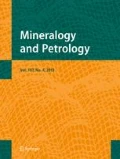Summary
“Egyptian Alabaster” (marble) exhibits a variety of structures the most common of which are: botryoidal structure, banding, cockade structure, vugs and cavities. Banding which is a characteristic feature consists of alternating translucent and white bands of different sizes. The mineralogical composition of the translucent bands has been determined as magnesian calcite and that of the milky-white bands as normal calcite. Differences in the Ca/Mg and Sr/Ca ratios between both types of bands have been noticed and are attributed to differences in the solubilities of Ca−, Mg−, and Sr-carbonates. The origin of the marble is discussed and is considered to be the product of recrystallization of limestone.
Zusammenfassung
„Agyptischer Alabaster” (Marmor) zeigt eine Reihe von Strukturen, von denen am häufigsten sind: traubige Struktur, Bänderung, Kokarden-Struktur, drusige und löchrige Struktur. Die charakteristische Bänderung besteht aus abwechselnd durchscheinenden und weißen Bändern wechselnder Stärke. Die mineralogische Zusammensetzung der durchscheinenden Bänder wurde als Mg-haltiger Calcit und die der milchig-weißen Bänder als gewöhnlicher Calcit bestimmt. Unterschiede im Ca/Mg- und Sr/Ca-Verhältnis zwischen den beiden Typen der Bänder wurden beobachtet; sie werden Löslichkeitsunterschieden der Ca−, Mg− und Sr-Karbonate zugeordnet. Die Genese des Marmors wird diskutiert; er wird als Rekristallisationsprodukt von Kalkstein angesehen.
Similar content being viewed by others
References
Akaad, M. K., andM. H. Naggar, 1963: Geology of the Wadi Sannur alabaster. Bull. Inst. Desert. Cairo13, 35–50.
——, 1964 a: Petrography of the Egyptian alabaster of Wadi El-Assiuty. Bull. Fac. Sci. Alexandria Univ.6, 157–167.
——, 1964 b: The deposit of Egyptian alabaster at Wadi El-Assiuty. Bull. Soc. Geogr. Egypt.36, 29–37.
——, 1965: Petrography of Wadi Sannur alabaster and its bearing on the mode of formation of Egyptian alabaster. Bull. Soc. Geogr. Egypt.37, 15.
Bissell, H. J., andG. V. Chilingar, 1967: Classification of sedimentary carbonate rocks. In: G. V. Chilingar, et al., Carbonate rocks, 9 A, Amsterdam: Elsevier.
Couyat, M. J., 1908: Sur quelques minéraux d'Egypte. Bull. Soc. Min. France31, 341–349.
El-Hinnawi, E. E., andS. M. Loukina, 1971: Petrography and chemistry of some Egyptian carbonate rocks. N. Jb. Geol. Paläont., Abh.138, 284–312.
Frolova, E. K., 1959: On classification of carbonate rocks of limestone-dolomite-magnesite series. Novosti. Neft. Tekhn. Geol.3, 34–37.
Hintze, C., (1930): Handbuch der Mineralogie.1. Bd., 3. Abt., 1. Hälfte, Berlin: Gruyter.
Müller, G., 1964: Methoden der Sediment-Untersuchung. Stuttgart: Schweizerbart.
Pytkowicz, R. M., 1965: Rates of inorganic calcium carbonate nucleation. J. Geol.73, 196–199.
Strunz, H., 1966: Mineralogische Tabellen. 4. Aufl. Leipzig: Akademische Verlagsgesellschaft.
Author information
Authors and Affiliations
Rights and permissions
About this article
Cite this article
El-Hinnawi, E.E., Loukina, S.M. A contribution to the geochemistry of “Egyptian Alabaster”. TMPM Tschermaks Petr. Mitt. 17, 215–221 (1972). https://doi.org/10.1007/BF01085995
Revised:
Accepted:
Issue Date:
DOI: https://doi.org/10.1007/BF01085995




